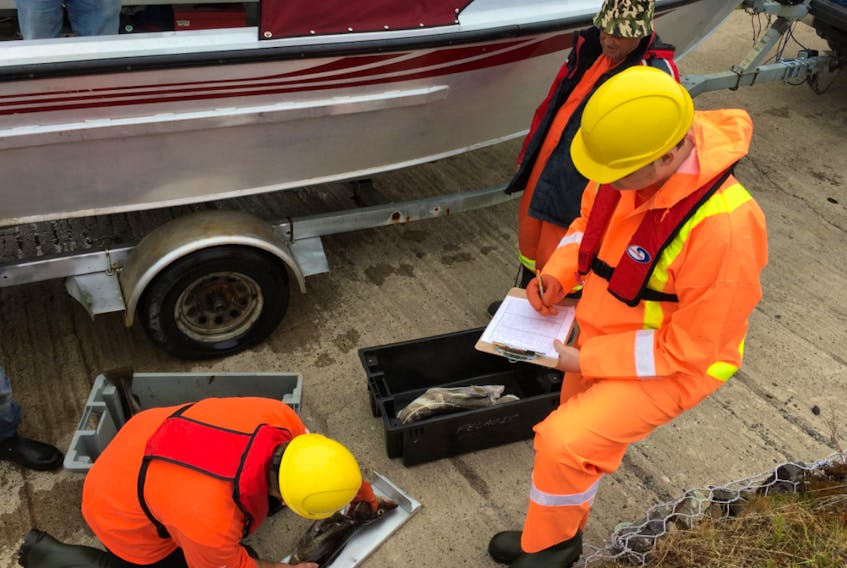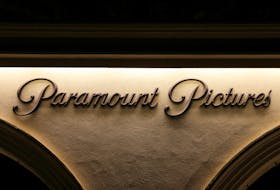Notwithstanding a car that perpetually reeked of fish, Madelyn Swackhamer is singing the praises of her summer job.
The 17-year-old from Bareneed, Conception Bay North, was one of 24 high school students hired by the Department of Fisheries and Oceans (DFO) for its inaugural Citizen Science Cod Project.
“It was an amazing experience for students who want to have a career in the sciences and maybe even a career in the marine sciences,” says Swackhamer, who, along with partner Kaitlyn Dawe, also of Bareneed, was stationed at the government wharf in nearby Port de Grave.
“I think it’s a great opportunity.”
The pilot project involved having pairs of students located at 11 landing wharves in communities on the Northeast Avalon, Conception Bay, Trinity Bay, Bonavista Bay and Notre Dame Bay throughout the course of the province’s summer and fall recreational food fisheries.
The students were charged with recording data on how many fish are being caught, the length of each fish, and the arrival and departure of participating vessels.
Ben Davis, the DFO aquatic resources division manager who oversees stock assessments, says the data will be used in conjunction with that obtained from surveys conducted by research trawlers, catch information from commercial landings, sentinel surveys and collaborative surveys with the fish harvesting sectors.
“The recreational fishery is one of those activities where people are landing all over the place on government wharves, on stages all over the area where cod can be fished. We’ve struggled at times to get good information on actually how many fish come out in the recreational fishery.”
By the time the fall fishery wrapped up on Oct. 1, the students had measured more than 25,000 fish across the province.
“It exceeded our expectations,” says Davis.
But the pilot project was about more than the acquisition of valuable stock assessment data.
Davis says another objective was establishing a DFO science program that was supported by the communities and something they could be part of.
“It became a community activity of, ‘Let’s figure out what’s coming in over our wharf and let’s take some pride in being able to participate in this and contribute to science,’” explains Davis.
Swackhamer, who admits she had never so much as touched a fish before starting the job, says fishery participants were a little wary at first, but it didn’t take long for them to become enthusiastic once the goal of the project was explained.
“What started with us running to them to measure the fish, they were soon coming to us to get measured,” she says.
“We had our regulars that would come in every morning and we would always measure them and by the end of it we were on a first-name basis with almost everyone down there.”
In some communities it even became something of a contest to see who would catch the biggest fish any given day. For the record, the largest cod, measuring 113 centimetres, was landed in Petty Harbour, where they also recorded the most number of fish landed, at more than 5,000.
Davis says it helped that the students were from the local area.
“They were known to the communities and they were great students, really outgoing and engaged, and they made a lot of friends and really were ambassadors for science on the wharves.”
But the benefits of the project don’t stop there. It also served to introduce more students to the possibility of a career in the marine and fishery sciences.
Davis says they’ve struggled to recruit people to work in Newfoundland — seven people, for instance, who were recently offered a research scientist position turned it down.
“By recruiting high school students to do this work, we’ve got their attention. If they want to be mentored and coached along the way of their education through university or technical colleges, then we’d be here to give them some help and guidance,” he says, singling out the Marine Institute’s new graduate program in fishery science as a great option for those thinking about the career path.
“I would say there’s a very good chance if people wanted to go through that program they could get a job here.”
For her part, Swackhamer had always been considering a career in the sciences, but after her experience on the Port de Grave wharf, she’s leaning heavily toward marine science.
“Just getting down on the wharf and learning about the fishery and about what happens and the different types of codfish was really interesting for me and made me want to pursue a career in it.”
As with most government-run projects, funding will dictate whether or not DFO tries this again next summer, but Davis is hopeful the community reception and overall success will make it happen.
If it does, he hopes they can get the latitude to acquire more biological information such as sex, age, feeding habits and more.
Twitter: kennoliver79









